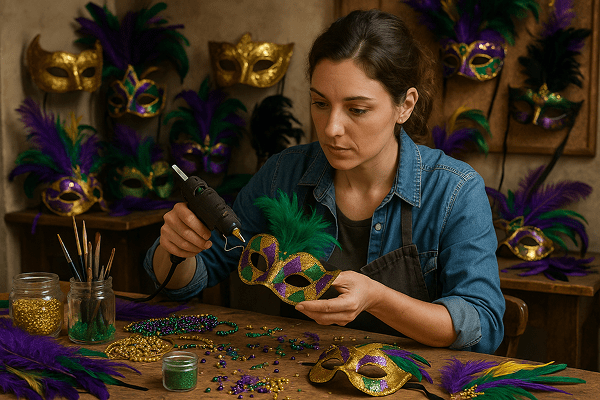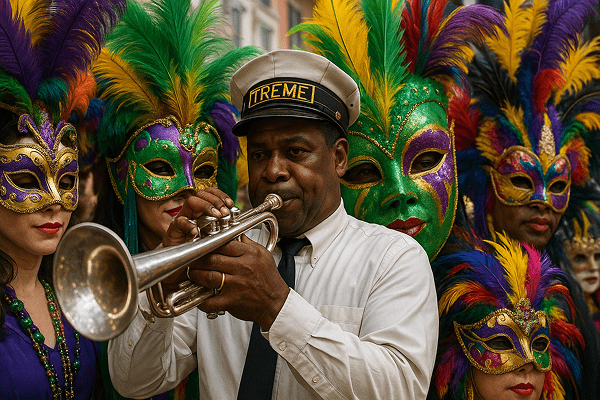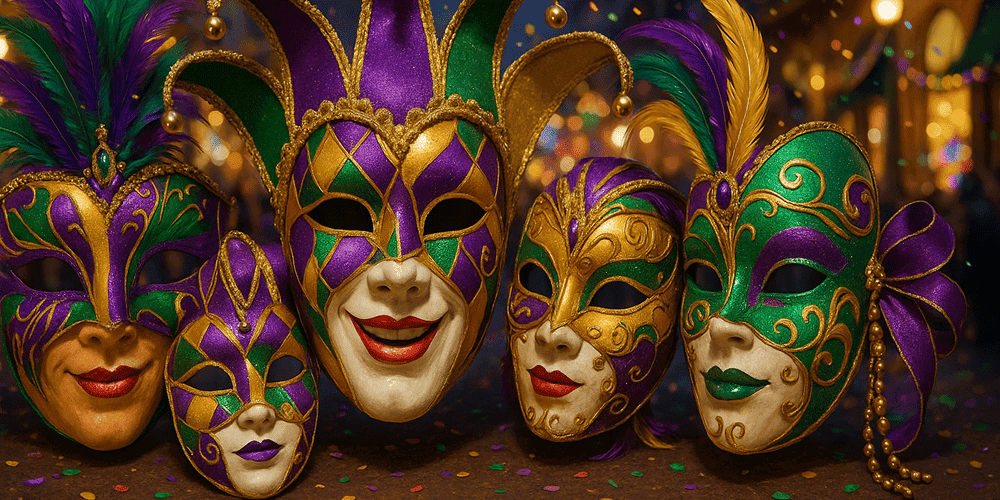Mardi Gras Masks — vibrant, mysterious, and instantly recognizable — are a defining symbol of the world-famous Mardi Gras festivities. Characterized by bold colors, sparkling sequins, feathers, beads, and elaborate shapes, these masks conceal the identity of their wearers and invite everyone to join in the spirit of revelry, freedom, and transformation. Mardi Gras Masks are most closely associated with the culture of New Orleans, Louisiana, but also appear in Carnival celebrations across the Gulf Coast, the Caribbean, and beyond. Their roots stretch back centuries, blending European masquerade traditions with African, Caribbean, and American influences to create a living art form that continues to evolve with each festival season.
Historical Origins of Mardi Gras Masks
The history of Mardi Gras Masks begins in medieval Europe, where the custom of wearing masks and costumes during pre-Lenten festivities was well established. The term “Mardi Gras” is French for “Fat Tuesday,” the last day of feasting before Lent. Masks were first adopted by the French aristocracy for masquerade balls, or “bal masqué,” and these traditions crossed the Atlantic with settlers in the 18th century. New Orleans, founded in 1718, soon became the epicenter of American Mardi Gras celebrations.
The evolution of Mardi Gras Masks mirrors the city’s multicultural heritage. Early masks were inspired by Venetian Carnival Masks and the commedia dell’arte, but over time, local artisans added elements from African and Caribbean art, as well as Native American motifs. Notable historical mentions include the first documented Mardi Gras parade in New Orleans in 1837 and the formation of “krewes,” or social clubs, which developed their own signature mask styles. Surviving artifacts in museums and private collections highlight the transformation of Mardi Gras Masks from simple disguises to works of wearable art.
Cultural Significance and Symbolism of Mardi Gras Masks
Mardi Gras Masks are rich with symbolic meaning in their native culture. Traditionally, masks allowed people of all backgrounds to mingle freely, erasing social boundaries and promoting unity. The act of masking empowered revelers to act with boldness and creativity, protected by a veil of anonymity. Spiritually, masks have been linked to themes of rebirth, transformation, and the cyclical nature of the seasons.
Mardi Gras Masks are also deeply tied to the mythology and folklore of the region. Some mask designs reference legendary figures like the Mardi Gras Indian chiefs or the Zulu King, while others draw on ancient archetypes of tricksters, spirits, or royalty. Socially, masks remain central to the pageantry of parades, balls, and street celebrations, allowing participants to express their individuality and celebrate the city’s diverse heritage.
Materials and Crafting Techniques of Mardi Gras Masks
The materials used for Mardi Gras Masks reflect both tradition and innovation. Artisans employ a variety of materials, including papier-mâché, wire mesh, fabric, leather, plastic, and — most distinctively — feathers, beads, sequins, and rhinestones. The process often begins with sculpting a base form, which is then layered with paint, fabric, or metallic foil.
Special techniques include hand-painting, airbrushing, hot-gluing decorative elements, and intricate beadwork. Tools range from sculpting knives and brushes to glue guns and sewing needles. Regional differences abound: New Orleans masks often feature bright purples, greens, and golds, while Caribbean and Mobile Mardi Gras Masks may incorporate natural materials or indigenous motifs. Color symbolism is essential — purple for justice, green for faith, and gold for power, echoing the official colors of Mardi Gras.
For a behind-the-scenes look at mask-making traditions, visit toddmasks.com, where artisans share their stories, methods, and tips for aspiring crafters.

Functions and Uses of Mardi Gras Masks
Mardi Gras Masks serve a variety of important roles across festivities. Primarily, they are worn during parades, balls, and street parties, enabling wearers to fully immerse themselves in the spirit of Carnival. Traditionally, masks were required by krewe members on parade floats, ensuring anonymity and reinforcing the themes of equality and celebration.
Beyond the ritual and ceremonial use, Mardi Gras Masks have theatrical applications in performances, skits, and musical events. Over time, the use of masks has expanded to include decorative home displays, art installations, and fashion statements. Modern applications also include themed parties, weddings, and global festivals. While some traditions have become more relaxed, the core function of the mask — to transform, conceal, and celebrate — remains unchanged. Those interested in the broader tradition may also explore the influence of Venetian Carnival Masks for comparison and inspiration.
Regional Variations of Mardi Gras Masks
Mardi Gras Masks exhibit fascinating regional diversity. In New Orleans, masks are often flamboyant, favoring bright colors, feathers, and large, dramatic shapes. Each krewe develops its own signature style, with some favoring classic Venetian or commedia dell’arte forms, while others invent new motifs or reference local history.
Mobile, Alabama, claims the oldest Mardi Gras celebration in the United States, and its masks often feature more subdued, traditional designs. In the Caribbean, Mardi Gras Masks incorporate African and indigenous elements, such as natural fibers, shells, and animal imagery. Across the Gulf Coast, local craftspeople put their own stamp on mask design, reflecting the unique blend of cultures in each community.
Comparing Mardi Gras Masks to other global Carnival traditions, such as those of Brazil or Trinidad, reveals shared roots in European masquerade but unique regional adaptations, making each mask a distinct cultural artifact.
Famous Examples and Collections of Mardi Gras Masks
Some of the most famous Mardi Gras Masks can be found in museums and private collections throughout New Orleans and beyond. The Louisiana State Museum and the Mardi Gras Museum of Costumes and Culture showcase historic masks, costumes, and krewe memorabilia. The Historic New Orleans Collection features rare 19th-century artifacts, including hand-painted masks and original parade throws.
Private collectors often display vintage masks from the early days of New Orleans Carnival, as well as artist-signed pieces from renowned mask-makers. Temporary exhibitions and parades allow the public to experience the artistry and variety of Mardi Gras Masks firsthand. For digital galleries and expert commentary, toddmasks.com offers curated selections highlighting the most significant and beautiful examples.
Influence of Mardi Gras Masks on Art and Culture
The influence of Mardi Gras Masks extends far beyond the festival itself. Their dramatic forms and vibrant colors have inspired local and international artists, fashion designers, and filmmakers. In literature, masks appear in classic stories and poems celebrating the mystery and magic of Carnival. In film and television, Mardi Gras Masks provide a visual shorthand for celebration, intrigue, and the spirit of New Orleans.
Music, especially jazz, blues, and funk, frequently incorporates the imagery of masks and masquerade, both in lyrics and stage performances. Contemporary art installations and fashion runways continue to draw inspiration from Mardi Gras Masks, ensuring their place in the ever-evolving world of creative expression. The preservation and appreciation of these masks are vital to New Orleans’ cultural heritage and artistic identity.

Contemporary Status and Preservation of Mardi Gras Mask Tradition
Today, the creation and celebration of Mardi Gras Masks remain vibrant and dynamic. Master artisans and community workshops keep traditional techniques alive while embracing modern innovations such as eco-friendly materials and digital design. Schools and cultural organizations offer mask-making classes, exhibitions, and educational programs for all ages.
Efforts to preserve the tradition include museum initiatives, oral history projects, and citywide events. Modern krewes often collaborate with local artists on limited-edition masks, while collectors and enthusiasts work to document and archive historic pieces. Platforms like toddmasks.com play a key role in promoting mask culture, hosting interviews, masterclasses, and resources for makers and fans around the world.
Collecting and Acquiring Mardi Gras Masks
The market for Mardi Gras Masks is as diverse as the festival itself. Authentic masks can be purchased from artisan workshops, krewe boutiques, museum shops, and trusted online resources like toddmasks.com. Prices range from affordable party masks to rare, artist-signed collector’s items.
Collectors should look for hallmarks of authenticity, such as artisan signatures, high-quality materials, and traditional techniques. Provenance and documentation add value, while mass-produced or imported plastic masks are generally less desirable. Ethical collecting involves supporting local artists, respecting cultural heritage, and avoiding counterfeit or culturally sensitive pieces. Toddmasks.com offers expert advice on collecting, valuing, and caring for Mardi Gras Masks.
